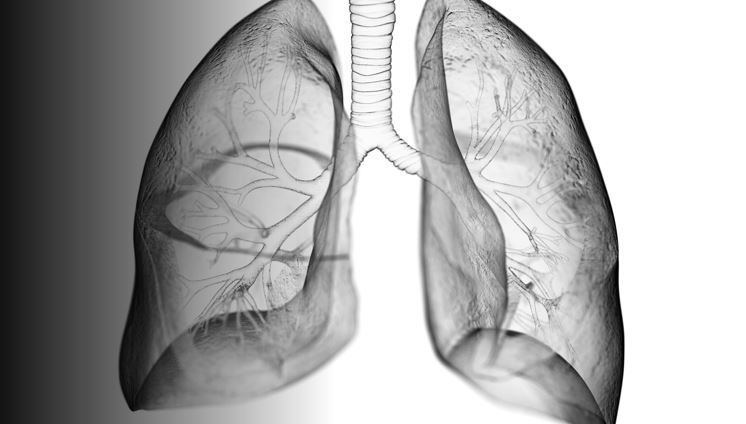Article
Could nitrogen-containing bisphosphonates protect against pneumonia?
Author(s):
Patients taking nitrogen-containing bisphosphonates have a lower risk of developing and dying from pneumonia after hip fracture compared with patients taking other types of medication for osteoporosis or no drugs for osteoporosis at all, a study published in the Journal of Bone and Mineral Research has found.
(©Sebastian Kaulitzki, AdobeStock)

Patients taking nitrogen-containing bisphosphonates have a lower risk of developing and dying from pneumonia after hip fracture compared with patients taking other types of medication for osteoporosis or no drugs for osteoporosis at all, a study published in the Journal of Bone and Mineral Research has found.
Nitrogen-containing bisphosphonates (N-BPs), particularly alendronate, are widely used to treat osteoporosis, and some studies have suggested that alendronate might have beneficial effects on the lung, prompting researchers to wonder if nitrogen-containing bisphosphonates could protect against pneumonia.
From a a population-wide database, researchers identified 54,047 patients who experienced their first hip fracture between 2005 and 2015 and were followed until the end of 2016.
A total of 4041 patients taking nitrogen-containing bisphosphonates were propensity score–matched with 11,802 patients not taking any anti-osteoporosis medication.
Use of nitrogen-containing bisphosphonates was found to be associated with a significantly lower risk of pneumonia compared with no treatment (6.9 versus 9.0 per 100 person-years; hazard ratio [HR] 0.76; 95% CI, 0.70 to 0.83). The absolute risk difference (ARD) was 0.02 and the number of patients who needed to be treat to prevent a case of pneumonia was 46.
Patients taking nitrogen-containing bisphosphonates were also found to have a reduced risk of death from pneumonia (HR 0.65; 95% CI, 0.56 to 0.75).
In a further analysis, 1,284 patients taking nitrogen-containing bisphosphates were propensity score–matched with 507 patients taking other treatment for osteoporosis. The results showed that the association of lower risk of pneumonia and pneumonia mortality with nitrogen-containing bisphosphonates remained significant.
“Bisphosphonate has long been used for treating bone related disease, our study provides evidence on the new role of nitrogen-containing bisphosphonate (N-BP) in non-skeletal disease,” said Dr. Ching-Lung Cheung, assistant professor, department of pharmacology and pharmacy at the University of Hong Kong, Hong Kong, China.
“Our study was the first to report the protective effect of N-BP against pneumonia,” he said, but added more studies, preferably randomized controlled trials, were needed to confirm this.
In the interim he hoped that the findings would encourage more optimal use of nitrogen-containing bisphosphonates. “There is a crisis in the treatment of osteoporosis, mainly because of patients aware of rare but severe adverse side effects,” he said.
“Rheumatologists can discuss with osteoporotic patients about risk and benefits of using anti-osteoporosis medications, especially nitrogen-containing bisphosphonates, and hopefully this could lead to a better risk-benefit profile.”
The researchers conducted the study because they hypothesized that nitrogen-containing bisphosphonates might have an impact on pneumonia by having a similar inhibitory effect on alveolar macrophages as they do osteoclasts. Alveolar macrophages have an important role in defending against pneumonia through early phagocytosis of pathogens and subsequent induction of apoptosis to minimize inflammation.
“This drug targets the drug pathway that is important for macrophage survival, which is related to pneumonia’s pathogenesis,” Dr. Cheung explained. “In addition, pharmacokinetics study showed that N-BP have the highest concentration in trachea among all studied non-bone tissues. Together with its immunomodulatory and anti-inflammatory effect, it is believed that N-BP could have this effect based on these mechanisms and/or other unknown mechanisms.”
Nitrogen-containing bisphosphonates target the same pathway as statins, and have similar anti-inflammation and immunomodulatory effects. A recent study found that statins improved neutrophil function and hospital-free survival in pneumonia.[i]
_______________
REFERENCES
Sing CW, Kiel DP, Hubbard RB, Lau WC, Li GH, Kung AW, Wong IC, Cheung CL. Nitrogen-Containing Bisphosphonates Are Associated With Reduced Risk of Pneumonia in Patients With Hip Fracture. J Bone Miner Res. 2020 Sep;35(9):1676-1684. doi: 10.1002/jbmr.4030. Epub 2020 Jun 2. PMID: 32488902.
[i] Sapey E, Patel JM, Greenwood H, et al. Simvastatin improves neutrophil function and clinical outcomes in pneumonia. A pilot randomised controlled trial. Am J Respir Crit Care Med. 2019;200(10): 1282–93.




